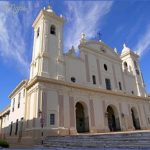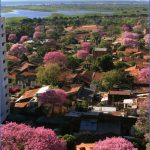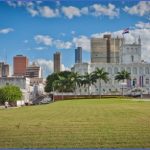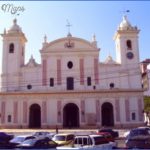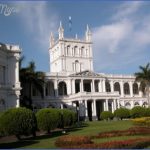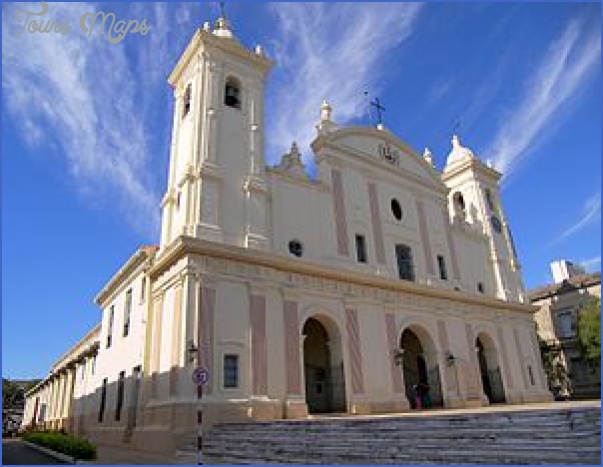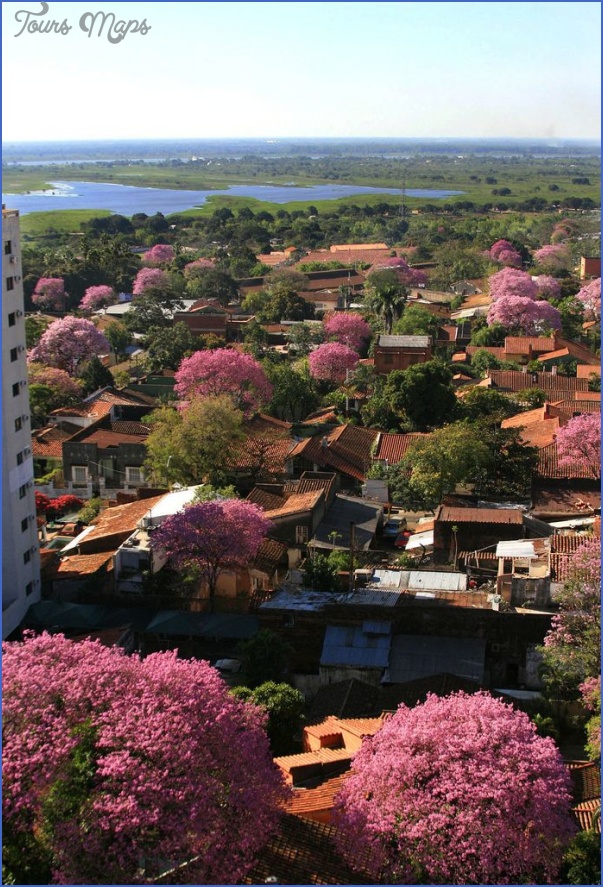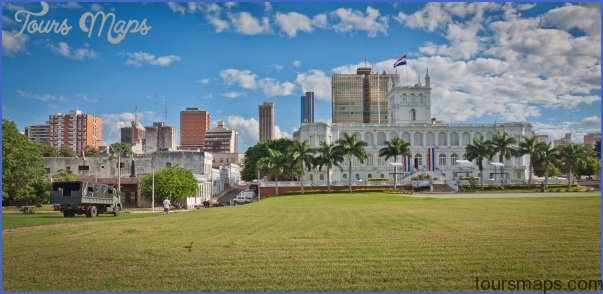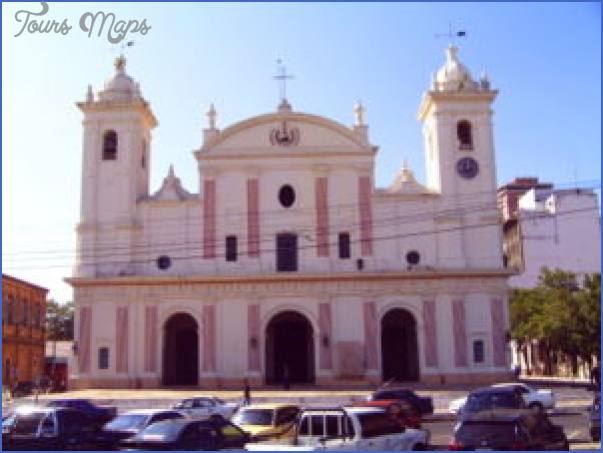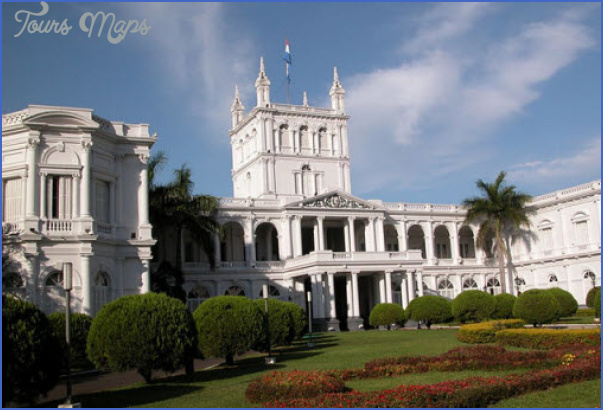Departamento Itapua
The department of Itapua is home to Paraguay’s most visited tourist attractions – the Jesuit ruins. There are three sets of ruins – those of Trinidad, Jesus de Tavarangue, and San Cosme y Damian. Of the three two have been declared UNESCO World Heritage sites. Due to the quantity of remaining structures and quality of their preservation, (as well as proximity to the main road) Trinidad is the most popular set of Jesuit Ruins. Tourists have two choices for lodging – they can stay in the city of Encarnacion itself or in one of several hotels along Route 6. The former offers the advantage of multiple options for eating out while the latter provides the opportunity to take in some of Itapua’s natural scenery.
Aside from its rich heritage Itapua is known primarily for its agricultural production. The area’s fertile soil has attracted a wide variety of immigrants – from Brazilians and Germans to Ukrainians and Russians. These groups have set up several agricultural colonies throughout the department farming rice, cotton, and soy, among other crops. The southern section of Ruta 6 (which connects Encarnacion with Ciudad del Este to the North) is home to the German towns of Hohenau, Obligado and Bella Vista collectively known as the Colonias Unidas (www.colonias.com.py) which produce Colon brand yerba mate and Los Colonos brand dairy products. Historically this area was used by the Jesuits to produce yerba mate. Today the city of Bella Vista is home to some of Paraguay’s largest yerba mate factories – of which two are open to the public. To the north, heading into the department of Alto Parana, Brazilian colonies dominate. Many of Itapua’s agricultural colonies are amongst the country’s most prosperous. Unlike the Mennonite colonies of the Chaco and Alto Parana these communities make full use of their wealth to obtain modern commodities such as satellite dishes and high speed internet.
Unfortunately an exceedingly rapid rate of deforestation has come hand in hand with the surge in large scale agriculture. Within the last thirty to forty years the extensive Atlantic Forest that once covered the department has all but vanished. The San Rafael Reserve encompasses what is left. – a small island of forest surrounded by a sea of soy fields. For those interested in admiring the remaining Atlantic Forest’s flora and fauna are there are two lodging options – the PROCOSARA lodge and the Kanguery birding station run by Guyra Paraguay. Though somewhat difficult to access both are worth the trip to see one of Paraguay’s most biologically rich ecosystems.
Coronel Bogado
Before arriving at Encarnacion Route 1 passes through Coronel Bogado, known as the chipa capital of Paraguay.
Indeed the chipa in Coronel Bogado is excellent. Two chiperia recommendations are the previously lauded Chiperia El
Gordo and Chiperia Tati, both with stands along Route 1.
ENCARNACION
Known as La Perla del Sur (the Pearl of the South) Encarnacion is Paraguay’s southern most city located along the Paraguay River across from the Argentine city of Posadas. The capital of the department of Itapua, Encarnacion is a pleasant city. Most tourists use Encarnacion as a base of operations for visiting Posadas or the nearby Jesuit ruins. Though there is not much to see in the city itself it is small and manageable with a handful of good ethnic restaurants. The city’s main plaza (Plaza de Armas) is very nice and the newly constructed boardwalk (la costanera), complete with a Wi-Fi signal, is gaining popularity.
The city is well known throughout Paraguay for its energetic and colorful celebration of Carnaval. Taking place over several weekends preceding Lent, the Carnavales Encarnacenas are quite a spectacle. Each night expectant crowds fill the bleachers set up along the city’s new boardwalk. One by one teams with parade to the tune of the batucada drum line’s fast samba beat which inspired the Carnaval route’s name: El Sambodromo. Each team or comparsa has a minimum of sixty dancers all decked out in tiny bedazzled bikinis and enormous feathered head dresses. All the plumage ends up making the women look like huge exotic birds (albeit partially naked ones). As they pass by the crowds cheer them on and spray each other with foam Carnaval is eagerly awaited both by the teams which practice their choreography and decorate costumes and floats for months in advance and spectators who travel from all over the country to enjoy the infectious party atmosphere.
Encarnacion’s economic activities mostly revolve around commerce with neighboring Argentine city Posadas. Though the commercial activities are not nearly as large in scale (or chaotic) as those of Ciudad del Este a fair amount of people cross the Puente Internacional San Roque Gonzalez bridge daily to take advantage of the more modern and varied offerings of Posadas and the cheaper imported goods available on the Paraguayan side. The city also has a young feel due to the amount of universities which are attended by many students from the nearby immigrant colonies. An interesting side effect of the city’s ethnic diversity is the relatively small amount of Guarani that is heard on the city streets.
Much of Encarnacion’s recent history has revolved around Yacyreta, a large hydroelectric power plant managed jointly by Paraguay and Argentina (see Central Hidroelectric Yacyreta). Though the dam itself is located ninety kilometers downriver in the town of Ayolas, Encarnacion is the most populated city upriver from the dam and therefore the most affected by its construction. After years of slowly increasing water levels the entire Zona Baja was completely submerged in 2010. This area was mostly comprised of the market where much of Encarnacion’s commercial trade with Argentine neighbor city Posadas took place. The process of relocating the area’s residents was long and drawn out, consistently dominating national headlines over the last twenty years. As with the Itaipu Dam, the amount of money generated coupled with very few audits has made the Entidad Binacional Yacyreta (known as la Entidad) which runs the hydroelectric plant a constant source of corruption scandals involving the alleged misdirection of EBY funds and conflicts with inhabitants of the projected flood zone.
Tourists who wish to continue on to Iguazu falls may find Encarnacion to be a preferable point of departure over Ciudad del Este to the north. Though further away, Encarnacion offers the distinct advantage of a much calmer border crossing. From the Posadas bus station there are several daily buses that make the trip to Puerto Iguazu as well as to the Argentine Jesuit Ruins of San Ignacio Mini.
Asuncion Travel Photo Gallery
Maybe You Like Them Too
- The Best Cities To Visit in The World
- World’s 10 Best Places To Visit
- Coolest Countries in the World to Visit
- Travel to Santorini, Greece
- Map of Barbados – Holiday in Barbados

